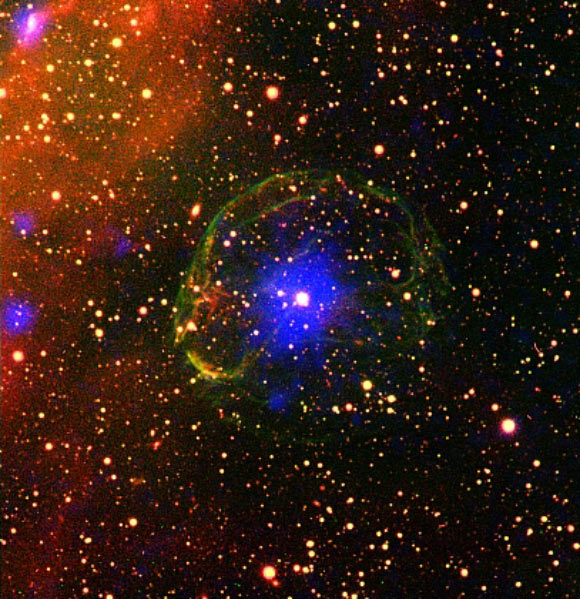The discovery of the largest timing irregularity yet observed in a pulsar is the first confirmation that binary pulsars (pulsars orbiting with a companion white dwarf or neutron star) exhibit the phenomenon known as a glitch.

Composite image of the X-ray pulsar SXP 1062 surrounded by the supernova remnant. The false-color image combines X-ray (blue) and optical data (oxygen – green, hydrogen – red). Image credit: ESA / XMM-Newton / L. Oskinova, University of Potsdam / M. Guerrero, Instituto de Astrofisica de Andalucia / Cerro Tololo Inter-American Observatory / R. Gruendl & Y. H. Chu, University of Illinois at Urbana-Champaign.
Pulsars are one possible result of the final stages of evolution of massive stars.
Such stars end their lives in huge supernova explosions, ejecting their stellar materials outwards into space and leaving behind an extremely dense and compact object; this could either be a white dwarf, a neutron star or a black hole.
If a neutron star is left, it may have a very strong magnetic field and rotate extremely quickly, emitting a beam of light that can be observed when the beam points towards Earth, in much the same way as a lighthouse beam sweeping past an observer.
To the observer on our planet, it looks as though the star is emitting pulses of light, hence the name ‘pulsar.’
Now, astronomers have discovered a sudden change in the rotation speed of SXP 1062, a binary (accretion-powered) pulsar located in the Small Magellanic Cloud.
These jumps in frequency, known as ‘glitches’, are commonly seen in isolated pulsars, but have so far never been observed in binary pulsars.
“SXP 1062 is particularly interesting, since as well as orbiting its partner star as part of a binary pair, it is also still surrounded by the remnants of the supernova explosion which created it,” said lead author M. Miraç Serim, a Ph.D. student at the Middle East Technical University in Ankara, Turkey.
The pulsar is thought to pull in the leftover material from the supernova explosion, feeding on it in a process known as accretion. The researchers believe that the size of the glitch is due to the gravitational influence of its companion star and this accretion of the surrounding remnant material, which together exert large forces on the crust of the neutron star.
When these forces are no longer sustainable, a rapid change in internal structure transfers momentum to the crust, changing the rotation of the pulsar very suddenly and producing a glitch.
“The fractional frequency jump observed during this glitch is the largest, and is unique to this particular pulsar. The size of the glitch indicates that the interiors of neutron stars in binary systems may be quite different to the interiors of isolated neutron stars,” said co-author Dr. Şeyda Şahiner, also from the Middle East Technical University.
The study is published in the Monthly Notices of the Royal Astronomical Society.
_____
M.M. Serim et al. 2017. Discovery of a glitch in the accretion-powered pulsar SXP 1062. MNRAS 471 (4): 4982-4989; doi: 10.1093/mnras/stx1771







